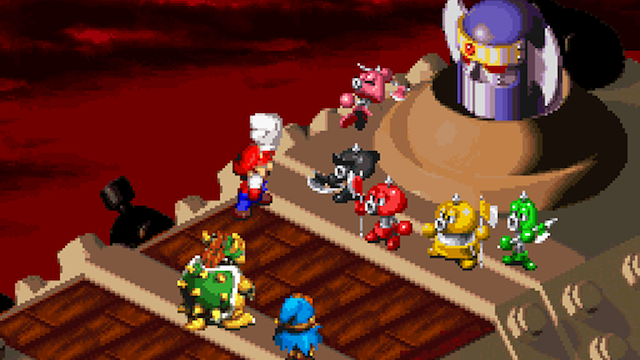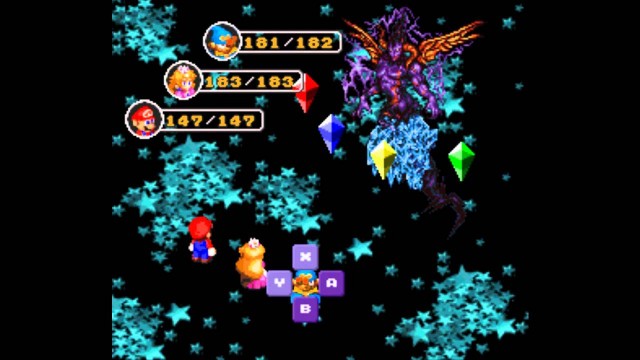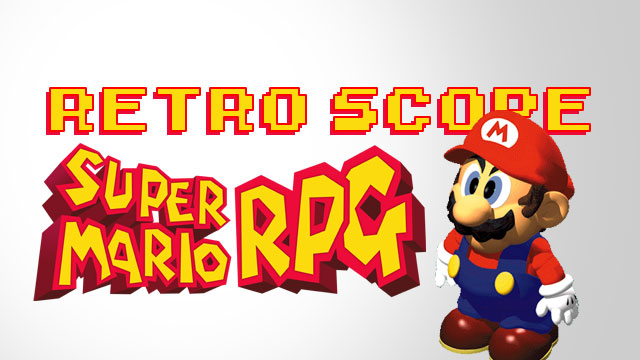The Mario RPG games– Mario & Luigi and Paper Mario, respectively– are some of the most prolific and successful franchises in the Nintendo canon, responsible for many of the most memorable and well-loved characters and moments in the Mario Bros. universe. However, before the X-Nauts and Sergeant Guy, and before Koops and Fawful, there were Geno and Mallow, Frogfucius and Boomer, and there was Super Mario RPG: Legend of the Seven Stars on SNES.
A collaboration between Square and Nintendo, Mario RPG brought together the traditional turn-based, menu-driven combat system and leveling-up through earning experience points that Square helped familiarize us with in RPGs like Final Fantasy, with the extremely quirky, colorful world of the Mushroom Kingdom. Unlike previous Mario games that played as side-scrolling platformers with very little dialogue and a basic storyline, Mario RPG threw players into a rich, complex plot that starts as the Bowser-steals-Peach routine (which gets poked fun at by Toads who voice exasperation at the princess being captured “AGAIN”) but explodes into so much more.
In the midst of Mario’s umpteenth rescue of Peach and trouncing of Bowser– not to mention an extremely creative opening sequence that puts you immediately into battle– a giant sword comes crashing downward into Bowser’s Keep, causing an earthquake that sends Mario flying all the way back to his humble home (aptly named “Pipe House”) and separates Mario and Peach yet again right before they’re reunited. When Mario attempts to make his way back into Bowser’s Keep, the giant sword, Exor, who exclaims that he is part of “Smithy’s Gang,” destroys the bridge allowing access into it. Thus begins Mario’s epic RPG quest to rescue Peach not from Bowser, but from an entirely new enemy.
The game’s isometric perspective and highly-animated 3D character models were state-of-the-art and visually impressive in 1996, pushing SNES’s graphical capabilities to its utmost potential. In today’s video game industry driven by the need for photorealism and hyper-detailed worlds, Mario RPG is a breath of fresh air, despite being 18 years old, because of its whimsical mix of the fantastical lands of the Mushroom Kingdom with a dash of 3D rendering, detailed environments, vibrant colors, and an art style blending elements of realism with the stylized look of the Mario universe. Coupled with one of the best and strongest soundtracks in any Mario game to date, Mario RPG shone brightly because of the radically different audio and visuals it chose to adopt to separate itself from previous entries in the Mario Bros. series. The RPG genre works well with Mario, and the battle and menu system is extremely easy to pick and understand: in battle you can attack with whatever weapons you have equipped, with special offensive and defensive moves your party members learn upon leveling up (which require “FP” or “Flower Points” to use), or you can use various items from your inventory. One of the most enjoyable parts about Mario RPG is collecting equipment to strengthen your party members and discovering the ones that appeal most to you, like Mario’s giant Lazy Shell, Bowser’s Spiked Link, or Peach’s Frying Pan (a weapon that would become so iconic for her that it would be one of the random items she uses in her B-button smash attack in the Smash Bros. series).

These gameplay elements, previously unknown to the Mario Bros. franchise, felt not like clunky, tacked-on additions, but rather were wonderfully executed, creating a smooth combat system that was easy to navigate and interactive for the player; pressing the attack button at the right moment would cause extra damage against enemies while pressing it as soon as an enemy attacked you would reduce the amount of damage you took. This prevented the game from being a standard turn-based RPG that involved little more than selecting a command and calculating damage. The combat animations of each character’s attacks also kept things visually interesting.
While Mario games are no strangers to introducing new characters, the sheer amount of personalities encountered in Mario RPG would set the stage for the types of colorful individuals that would be introduced in the later RPG games. From your first run-in with Mallow, the tadpole who doesn’t look like he’s a tadpole because (spoiler alert) he’s actually a cloud who also happens to be prince of Nimbus Land, to being united with Geno, the spirit of the warrior from Star Road that possess the body of a doll, whose real name is a series of unpronounceable characters and who serves a “higher authority,” Mario RPG creates a true level of depth within the heroes and villains alike that populate the game. It’s also the earliest example of Mario and Bowser working together rather than fighting, as well as players being able to take control of Mario’s antagonist; though Peach was first playable in Super Mario Bros. 2, it really is pretty epic when you finally have all three characters on your team, working together to fight an evil too great for them to not put their differences aside for a greater good. While on the subject of evil, one can’t forget the outlandish and outrageous enemies that you can’t help but laugh at and despise all at once, along with the formidable and familiar: the Axem Rangers, a clear parody of the Power Rangers but a lot less competent of a team; Booster, the jilted lover with delusions of marrying Peach and whose friends have a gambling problem; Valentina, who might be the first example of a character featuring a “jiggle animation” in a Nintendo game; Jinx, the extremely skilled, extremely serious, and extremely small ninja that will probably require two tries to take down; Culex, Square’s epic-but-creepy homage to its beloved Final Fantasy series tucked away in Monstro Town; and even Birdo, the androgynous frenemy we’ve all come to love and be very confused by.

Battle with Culex, Square’s homage to Final Fantasy within the game.
And we can’t forget the cameos by other familiar Nintendo faces, like Link taking a snooze in the inn in Rosetown and hearing the Zelda “secret” jingle when you attempt to wake him, or Samus “resting up for Mother Brain” in the guest room of the castle of the Mushroom Kingdom, and even stumbling upon Yoshi and his friends on Yo’ster Island (though, sadly, he doesn’t join your party).
I had initially thought that Mario RPG was perhaps longer than it really was because the majority of my memories of it are from my elementary school days, but it is, in fact, a very long game that is worth every second you put into it. From journeying to save the Mushroom Kingdom from Smithy and his minions, to leveling up and customizing your party, to experiencing the witty writing and genuinely funny humor, the adventure avoids being the grind that a lot of RPGs end up becoming toward the latter half of the game, and by the end you’ve grown emotionally involved and truly care about everyone you’ve spent so much time with.
Super Mario RPG: Legend of the Seven Stars is truly a game of epic proportions with the perfect balance of Nintendo charm and Square storytelling and gameplay that would open up the doors for further exploration into the melding of Mario and the RPG genre in the years to come. Wonderfully unique characters, a deeper storyline, an entirely different genre, and superb audio and visuals would make this spin-off one of the most iconic entries in the Mario series and one of the best games in the SNES library.




 ShareThis
ShareThis








Mario RPG is fascinating to play years later just to see some of the elements that Nintendo probably wouldn’t let slide now. The jiggle is probably one, and even descriptors of moves like Mallow’s “Psycopath” probably would have been renamed.
Unquestionably my favorite SNES game. The only one even close is Yoshi’s Island. (To be fair, I haven’t played Super Metroid yet. Blasphemy, I know.)
I need to find myself a copy of the instruction book, really… Have the game, have the box, but the instruction book is missing the cover. Like a dagger in my heart.